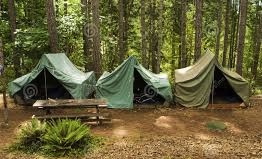I recall fondly my years as a Boy Scout growing up in Ft. Lauderdale, Florida. One of the highlights was a special camping trip to Lake Okeechobee, the second largest freshwater lake in the U.S. We set up our tents in a clearing shaded by towering trees bearded with Spanish moss. In the early morning hours we listened to the hammering of woodpeckers echoing through the woods. We fished and canoed, and chased armadillos from one palmetto patch to another. At night we sat around the fire, toasting marshmallows and telling ghost stories.
 When my son decided to join the Scouts it brought back memories of that Lake Okeechobee campout. I jumped at the chance to relive them when he told me about an upcoming father-son camping trip. The only problem was I hadn’t been camping since I left the Scouts, and we didn’t own a tent or any camping gear. After investing in some supplies, I borrowed a tent and sleeping bags from a friend and we joined the others for our outdoor adventure.
When my son decided to join the Scouts it brought back memories of that Lake Okeechobee campout. I jumped at the chance to relive them when he told me about an upcoming father-son camping trip. The only problem was I hadn’t been camping since I left the Scouts, and we didn’t own a tent or any camping gear. After investing in some supplies, I borrowed a tent and sleeping bags from a friend and we joined the others for our outdoor adventure.
What strikes me now about that camping trip, and still elicits guffaws at family gatherings, is my attempt to erect the tent. After wrestling with it for much longer than any other father-son duo—assembling poles, figuring out where they went, and fighting with the canvas—we looked at the sagging structure and realized something was definitely not right.
Son Greg shook his head, and gazed at the other tents standing tautly around us. “Something’s wrong here,” he offered, and went to find the Scoutmaster.
The Scoutmaster, a veteran of many camping trips, walked around our tent, tilting his head one way and then the other. A slight smile was on his face when he told us, “It looks like this thing’s upside down.”
That may have been a defining moment for Greg. The time when he realized his father was not the most competent person in the world when it came to assembling anything more complicated than a bowl of Cheerios with sliced bananas. And, of course, I’ve been known to slice the Cheerios instead of the fruit.
I tell you this embarrassing bit of family history to illustrate how it relates to writing a novel. There are writers, like Jeffrey Deaver, who spend months plotting and outlining their stories in advance. Other very accomplished writers, like Lee Child and Stephen King simply take a plot idea and jump in, uncovering their story and characters as they write.
The more structured writers are called Outliners or Plotters. The unrestricted writers who wouldn’t dream of tying themselves to an outline are referred to as seat of the pants writers, or Pantsers. I happen to be a combination of both, starting with a basic outline and making changes as I write and new avenues occur to me. But there is one constant in my process, and that is I know my ending in advance and work toward it.
Now I’m wondering if that’s like erecting the tent upside down. Am I going about it wrong? I’ve thought about it and I don’t think so because it seems to have worked for me.
What I’ve learned is that no two authors approach the process of writing in the same manner. There is no right or wrong. If the road maps we draw in advance, as opposed to following a built-in mental GPS, all lead to a finished product, then the journey has been successful.
Of course, if the road map isn’t followed, or it leads the writer into a confusing wilderness where armadillos run amok, then, like putting the tent up wrong, the story won’t have a happy ending.
Parker continues to work on his assembling skills as he writes his third Quint Mitchell Mystery. Look for Hurricane Island in 2014. In the meantime, start your holiday shopping now by purchasing any of his Quint Mitchell Mysteries, Matanzas Bay, Bring Down the Furies, and Blue Crabs at Midnight by clicking on the links. He’s also written the short story collection, Ghostly Whispers, Secret Voices, six dark and surprising tales.